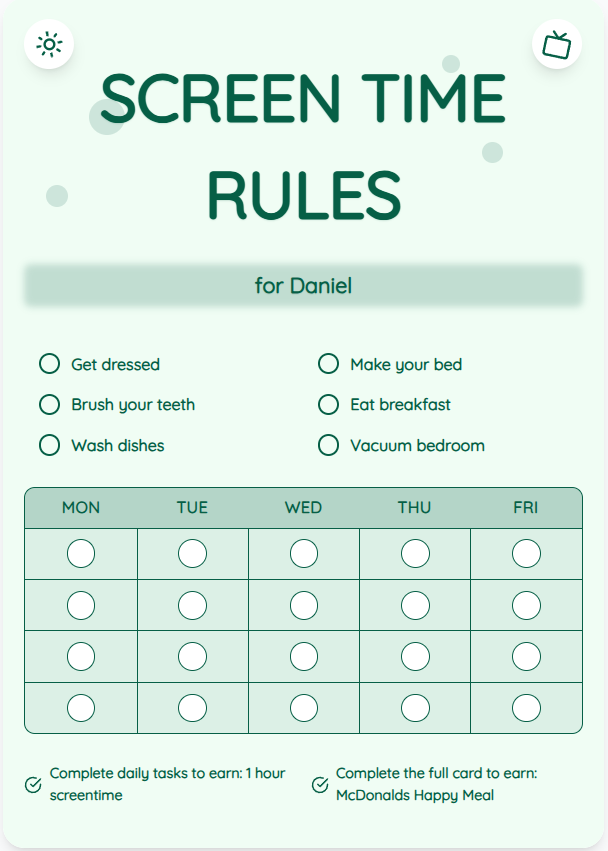Preventing Screen Time Eye Strain in Children: A Parent's Guide
As children spend more time on screens, the risk of eye strain has become a growing concern for parents. In this comprehensive guide, we will explore the impact of screen time on children's eyesight and provide actionable tips to prevent eye strain effectively.
See What Your Screen Time Chart Will Look Like
Here's an example of a beautiful, customizable screen time rules chart you can create for your family

Understanding Screen Time Eye Strain
Screen time eye strain, also known as computer vision syndrome, refers to the discomfort experienced after prolonged use of digital devices. Symptoms include dry eyes, headaches, blurred vision, and neck pain. Children are particularly vulnerable to eye strain due to their developing visual systems. Blue light emitted by screens can disrupt sleep patterns and affect overall eye health. It is crucial for parents to address these issues early on to safeguard their child's vision.
Practical Tips to Reduce Eye Strain
1. Set screen time limits: Establish clear rules for screen usage and encourage regular breaks. 2. Adjust screen settings: Optimize brightness, contrast, and font size to reduce eye strain. 3. Encourage outdoor activities: Promote outdoor playtime to give eyes a break from screens. 4. Use the 20-20-20 rule: Every 20 minutes, have your child look at something 20 feet away for 20 seconds. 5. Screen time charts: Utilize screen time charts to regulate and monitor your child's device usage effectively.
Put These Tips Into Action
Create a custom chart to implement these strategies with your child
Creating a Screen-Friendly Environment
Designate screen-free zones at home, such as the dining area and bedrooms, to promote healthy screen habits. Ensure proper lighting and seating ergonomics to reduce eye strain. Encourage good posture while using devices and educate your child about the importance of eye care.
Balancing Screen Time with Other Activities
Engage your child in diverse activities like reading, arts and crafts, sports, and social interactions to limit screen exposure. Model healthy screen habits yourself and involve the whole family in tech-free bonding experiences.
Practical Tips for Success
- Set clear screen time limits
- Adjust screen settings for optimal comfort
- Promote outdoor playtime
- Use the 20-20-20 rule
- Utilize screen time charts for monitoring
Frequently Asked Questions
How can I tell if my child is experiencing screen time eye strain?
Watch out for symptoms like eye redness, frequent rubbing of eyes, complaints of headaches, or squinting while looking at screens. Regular eye check-ups are also recommended.
Are all screens equally harmful to children's eyes?
While all screens emit blue light, smaller screens like smartphones and tablets are held closer to the eyes, increasing the risk of eye strain. Limiting exposure and following eye care practices are essential regardless of the device.
Can screen time charts really help in managing my child's device usage?
Yes, screen time charts provide a visual representation of allowed screen time, helping children understand limits and promoting responsible device use. Consistent use of screen time charts can lead to healthier screen habits.
By implementing these practical tips and fostering a balanced approach to screen time, you can protect your child's eyesight and promote overall well-being. Remember, moderation is key in managing screen time for healthier eyes and happier kids. Explore our screen time chart generator at ScreenTimeRules.com for personalized solutions tailored to your family's needs.
Ready to Transform Your Family's Screen Time?
Join thousands of parents who have successfully managed screen time with our customizable charts.
